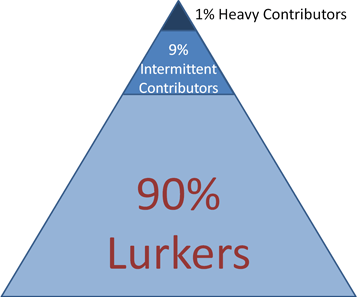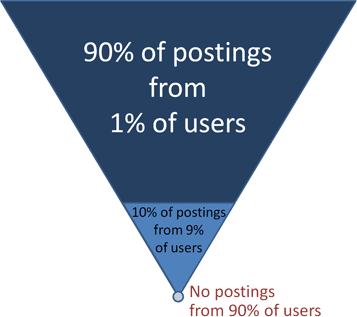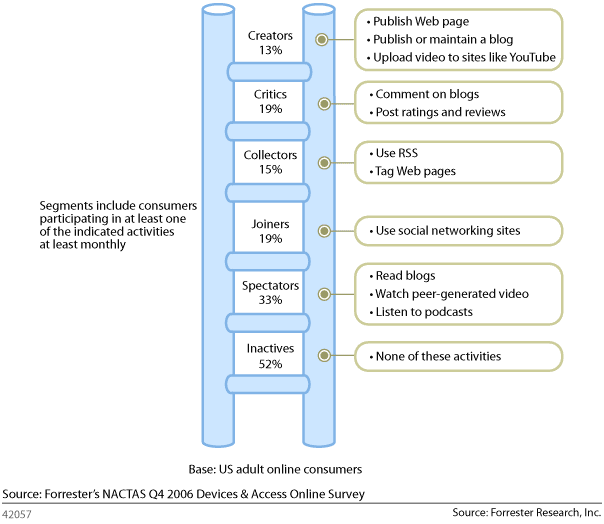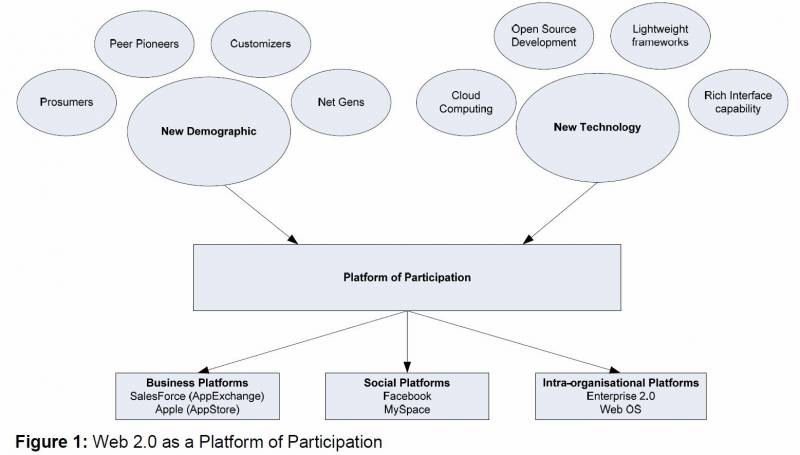4. Engagements
Tout le monde ne veut pas être intégré ni participer de la même façon et avec la même énergie ; c’est aussi valable pour les employés. Mais on sait aussi que plus la culture de l’entreprise est bonne, plus les collaborateurs s’y engagent. Donnez aux nouveaux acteurs la possibilité de s’intégrer de différentes manières.
Exemple pour la forme d’intégration “plateforme d’idée”. En moyenne, 10% des utilisateurs proposent une idée, peut-être 30% font des commentaires et 80% votent.
Pour résumer :
C’est à vous, entrepreneurs, de concrétiser les 4 paramètres pour offrir des possibilités variées de participation. Si c’est insuffisant aux yeux de vos utilisateurs ou consommateurs, ils vous le feront savoir.
Et c’est aussi à vous de stimuler et encourager la participation et les échanges. Il ne se passera rien ou trop peu si vous attendez les bras croisés que les nouveaux acteurs se manifestent. C’est comme pour le buzz ou le bouche à oreille : c’est un résultat souhaité et non un moyen de communication.
Comment procéder pour concrétiser les 4 paramètres ?
Vous décidez d’abord où vous voulez rendre perméable votre entreprise (1. perméabilités). Ensuite, qui vous voulez intégrer et de quelle manière (2. nouveaux acteurs et 3. intégrations). Et pour terminer vous proposez différentes formes d’engagement ou de participation (4. engagements).
Plus d’informations
Voici comment améliorer la règle des 90-9-1. A comparer avec le principe de Pareto : 20% d’un groupe de personnes produisent 80% du contenu.
http://www.useit.com/alertbox/participation_inequality.html
Participation Inequality: Encouraging More Users to Contribute
By Jakob Nielsen, October 9, 2006
User participation often more or less follows a 90-9-1 rule:90% of users are lurkers (i.e., read or observe, but don’t contribute).
9% of users contribute from time to time, but other priorities dominate their time.
1% of users participate a lot and account for most contributions: it can seem as if they don’t have lives because they often post just minutes after whatever event they’re commenting on occurs.How to Overcome Participation Inequality?
You can’t.The first step to dealing with participation inequality is to recognize that it will always be with us. It’s existed in every online community and multi-user service that has ever been studied.
Your only real choice here is in how you shape the inequality curve’s angle. Are you going to have the “usual” 90-9-1 distribution, or the more radical 99-1-0.1 distribution common in some social websites? Can you achieve a more equitable distribution of, say, 80-16-4? (That is, only 80% lurkers, with 16% contributing some and 4% contributing the most.)
Although participation will always be somewhat unequal, there are ways to better equalize it, including:
- Make it easier to contribute. The lower the overhead, the more people will jump through the hoop. For example, Netflix lets users rate movies by clicking a star rating, which is much easier than writing a natural-language review.
- Make participation a side effect. Even better, let users participate with zero effort by making their contributions a side effect of something else they’re doing. For example, Amazon’s “people who bought this book, bought these other books” recommendations are a side effect of people buying books. You don’t have to do anything special to have your book preferences entered into the system. Will Hill coined the term read wear for this type of effect: the simple activity of reading (or using) something will “wear” it down and thus leave its marks — just like a cookbook will automatically fall open to the recipe you prepare the most.
- Edit, don’t create. Let users build their contributions by modifying existing templates rather than creating complete entities from scratch. Editing a template is more enticing and has a gentler learning curve than facing the horror of a blank page. In avatar-based systems like Second Life, for example, most users modify standard-issue avatars rather than create their own.
- Reward — but don’t over-reward — participants. Rewarding people for contributing will help motivate users who have lives outside the Internet, and thus will broaden your participant base. Although money is always good, you can also give contributors preferential treatment (such as discounts or advance notice of new stuff), or even just put gold stars on their profiles. But don’t give too much to the most active participants, or you’ll simply encourage them to dominate the system even more.
- Promote quality contributors. If you display all contributions equally, then people who post only when they have something important to say will be drowned out by the torrent of material from the hyperactive 1%. Instead, give extra prominence to good contributions and to contributions from people who’ve proven their value, as indicated by their reputation ranking.
Un autre conseil: Bien connaître mes utilisateurs et avoir une approche cohérente et intégrale.
http://forrester.typepad.com/groundswell/2007/04/forresters_new_.html
Forrester’s new Social Technographics report
By Charlene Li (and Josh Bernoff) April 23, 2007Many companies approach social computing as a list of technologies to be deployed as needed – a blog here, a podcast there – to achieve a marketing goal. But a more coherent approach is to start with your target audience and determine what kind of relationship you want to build with them, based on what they are ready for. Forrester categorizes social computing behaviors into a ladder with six levels of participation; we use the term “Social Technographics” to describe analyzing a population according to its participation in these levels. Brands, Web sites, and any other company pursuing social technologies should analyze their customers’ Social Technographics first, and then create a social strategy based on that profile.
La technologie est de plus en plus simple et permet à toujours plus de personnes de devenir actives et créer du contenu.
http://www.wi2ki.de/doku.php/medienkompetenz
Medienkompetenz
By Themenpatin: Yvonne Gaedke / Autor: Thomas Mysliwitz, Michael May, Dominik SelitNach Tapscott und Williams (2007) sind für den Wandel der Technologien und der damit verbundenen Art der Nutzung des Internets zwei Faktoren ausschlaggebend:
Diese beiden Faktoren führen dazu, dass der Benutzer von einem „read-only“-Verhalten zum „read-write“-Verhalten übergeht und so nicht nur passiv teilnimmt, sondern aktiv mitgestaltet.
Quelle: Nagle, S., A Theoretical Lens to Examine the Structural Impact of Adopting Web 2.0
Prochain billet: 17/27 Conséquences
Cliquez le lien pour lire le premier billet 1/27 : diaporama et plan de présentation.
Vous pouvez télécharger la présentation sur SlideShare.
Source de l’image : http://www.cancoillotte.net/IMG/jpg/Foule_au_passage_des_echappes.jpg





